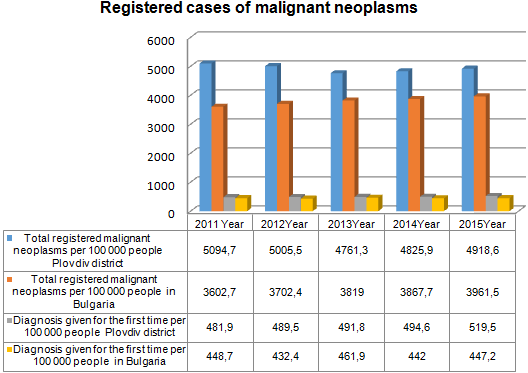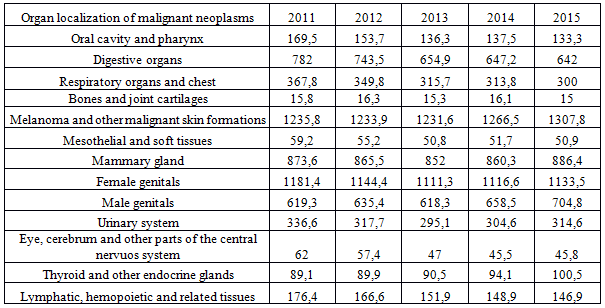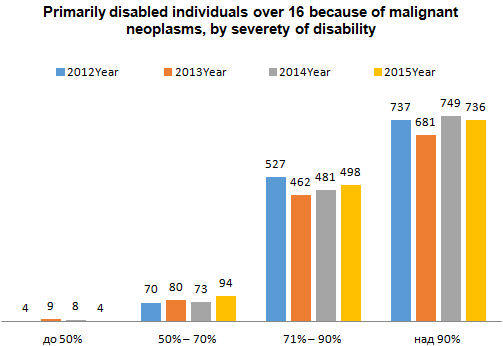MEDICAL EXPERTISE OF WORKING CAPACITY – A FACTOR OF ADEQUATE OCCUPATIONAL AND SOCIAL RE-ADAPTATION
Шопов Д.Г.1, Михайлова В.К.2, Стоев Т.С.3, Драгушева С.С.4
1Врач, доктор медицинских наук, профессор кафедры социальной медицины и здравоохранения Медицинский университет в г. Пловдив, Болгария, 2Кандидат медицинских наук, доцент. Кафедра превентивной медицины, Факультет общественного здравоохранения, София; Профессор кафедры менеджмента здравоохранения, Факультет общественного здравоохранения, Медицинский университет в г. Пловдив, Болгария, 3Кандидат медицинских наук, доцент кафедры менеджмента здравоохранения и экономики здравоохранения, Факультет общественного здравоохранения, медицинский университет в г. Пловдив, Болгария, 4Ассистент кафедры ухода за больными, Факультет общественного здравоохранения (FPH), Медицинский университет в г. Пловдив
МЕДИЦИНСКАЯ ЭКСПЕРТИЗА РАБОТОСПОСОБНОСТИ КАК ФАКТОР АДЕКВАТНОЙ ПРОФЕССИОНАЛЬНОЙ И СОЦИАЛЬНОЙ РЕАДАПТАЦИИ
Аннотация
Злокачественные заболевания являются важной и актуальной социально-значимой проблемой современного общества.
В статье анализируется динамика заболеваемости и инвалидность, вызванная злокачественными новообразованиями в различных органах среди населения Пловдивского района в течение 5 лет (с 2011 по 2015 год включительно). Обнаружены следующие факты:
- Заболеваемость злокачественными новообразованиями в Республике Болгария и особенно в Пловдивском районе имеет тенденцию к росту.
- Количество зарегистрированных лиц старше 16 лет в Пловдивском районе с постоянно сниженной работоспособностью, типом и степенью инвалидности в 2015 году составило 6050 человек, или 10,6 на тысячу человек за 16 лет, средний уровень по стране – 10,8.
- Относительная доля людей с инвалидностью выше 90% является самой высокой, за ней следуют люди с инвалидностью 71-90%, 50-70% и инвалиды до 50%.
- Наиболее частыми причинами инвалидности являются болезни органов кровообращения – 34,3% от общего числа зарегистрированных лиц, за ними следуют новообразования – 22,0%, заболевания глаз – 8,1%, заболевания эндокринной системы и пищеварительной системы, нарушения обмена веществ – 7,6%, заболевания костно-мышечной системы и соединительных тканей – 7,5% и т. д.
Shopov D.G.1, Mihaylova V.K.2, Stoev T.S.3, Dragusheva S.S.4
1MD, PhD, Chief Assistant Prof. Department of Social Medicine and Public Health Medical University-Plovdiv, Bulgaria, 2PhD, Assoc.Prof. Department of Preventive Medicine, Faculty of Public Health, Sofia, Chief Assistant Prof. Department of Healthcare Management, Faculty of Public Health, Medical University-Plovdiv, Bulgaria, 3PhD, Assoc.Prof.Department of Health management and Economy of healthcare, Faculty of Public Health, Medical University-Plovdiv, Bulgaria, 4Assistant Prof.Department Nursing Care, Faculty of Public Health (FPH), Medical University -Plovdiv
MEDICAL EXPERTISE OF WORKING CAPACITY – A FACTOR OF ADEQUATE OCCUPATIONAL AND SOCIAL RE-ADAPTATION
Abstract
Malignant diseases are an important and topical socially significant problem of the contemporary society.
The present article analyzes the dynamics of the morbidity and disability as a result of malignant neoplasms in different organs in the population of Plovdiv district for a 5-year period – from 2011 to 2015 inclusive. The following facts have been found out:
- Morbidity and suffering from malignant neoplasms in the Republic of Bulgaria and more particularly in Plovdiv district have an upward tendency.
- The number of registered individuals over 16 years of age in Plovdiv district with permanently reduced working capacity/type and degree of disability in 2015 was 6 050, or 10.6 per one thousand people over 16, compared with 10.8 for Bulgaria.
- The relative share of people with disability over 90% is the highest, followed by people with 71-90% disability, 50-70% and those with disability up to 50%.
- The most frequent causes of disability are diseases of the blood circulation organs, 34.3% of the total number of registered individuals. They are followed by neoplasms (22.0%), diseases of the eyes and their adjuncts (8.1%), the diseases of the endocrine system and digestion and metabolic disorders (7.6%), diseases of the bone and muscle system and the connective tissues (7.5%), etc.
Keywords: malignant diseases, population, disability, prophylaxis, working capacity, social re-adaptation
Introduction
Malignant diseases are an important and topical socially significant problem, therefore the society pays attention to all activities related to their treatment. According to data provided by the National Statistical Institute in Bulgaria, the newly registered cases of malignant diseases have increased – from almost 330 per 100 000 people in 2000, to 447.2 per 100 000 people in 2015, or 33.5% higher over a 15-year period. However, the total number of registered patients with oncological diseases has doubled – from almost 2400 per 100 000 people in 2000 to 3861.5 per 100 000 people in 2015, or 62% higher over a 15-year period. Thanks to the achievements of the contemporary medicine, patients with oncological diseases in Bulgaria now live longer than in 2000, which determines the increase in the total number of registered patients with malignant diseases. At the end of 2015 in Bulgaria there were 284 355 people with malignant diseases.[11,Р.15], [14,P.11] Such a large number of sick people among the population leads to new problems in the society, one of which is the adequate occupational and social re-adaptation. It turns to be a conclusive stage in the complex struggle with the oncological diseases. It is carried out by the bodies of the medical expertise and is an integral part of the diagnostic, treatment and prophylactic activity of the medical institutions, the specialists in the diagnostic and consulting centres and the general practitioners.[1,P.18],[2,84] The correct and competent assessment of the working capacity plays an important role for the different types of prophylaxis of oncological diseases. Primary prophylaxis of the malignant diseases is based on monitoring of patients working under certain occupational conditions. It is a task of the oncological and health and epidemiological services to combine their efforts in studying the conditions of the living and occupational environment of the people and its impact on the occurrence of malignant tumors, and to adopt measures for elimination or reduction of the harmful influence of the cancerogenic factors therein. The secondary prophylaxis is preconditioned by the achievements of contemporary oncology, which discloses the significance of the precanceroses in the genesis of oncological diseases.[5,P.34],[6,P.26] Early finding and treatment of precanceroses, elimination of the causes contributing to their occurrence, are one of the main elements of prophylaxis of oncological diseases. The patients must be subjected to constant hospital monitoring and treatment. Tetriary prophylaxis includes active follow-up of already diagnosed and treated patients – early beginning, continuation, complexity and individuality.[3,P.18],[4,P.29] The phyisician's assessment of the working capacity of an individual suffering from an oncological disease arouse significant personal-psychological, social-economical and socio-political consequences. They concern both the individual ,society. The medical expertise of the individuals suffering from oncological diseases as a social event is a complex and dynamic system of problems, which in its unique way combines the entire social structure and problematics.[8,P.90],[9,P.74],[10,P.56] The Health Act outlines the main elements of the legal provisions of the medical expertise of the working capacity, while the principles and criteria, and the terms and conditions of its implementation are stipulated in the Ordinance on medical expertise of 2010. The expertise of the temporary inability for work is performed by the physicians in charge, the medical advisory commissions (MAC), territorial expert medical commissions (TEМC), and the National expert medical commission (NEMC), and the expertise of the permanently reduced capacity for work or degree of disability is carried out only by TEMC and NEMC.
Objective of the present article is the study of the dynamics of the morbidity and disability rate caused by malignant neoplasms with different organ location in the population of Plovdiv district.
Material and methods:
Object of observation are patients with oncological diseases in Plovdiv district. The study is retrospective over a 5-year period – from 2011 to 2015 inclusive. Quantitative and qualitative indices have been used for the analysis. The primary information has been collected from the annual reports of the National Statistical Institute (NSI), Ministry of Health – Regional Health Inspection of Plovdiv, National Centre of Public Health and Analyses. The statistical processing of the collected primary information has been performed using a variation, alternative and non-parametrical analysis. The computer processing of the collected database has been performed using the statistical pack SPSS version 19 and Microsoft Excel.
Results and discussion:
Malignant diseases are among the main causes of death in Europe and in Bulgaria. At the end of the past millenium oncological diseases have caused death to every one of four Europeans. The neoplasm sick rate in the Republic of Bulgaria and more specifically in Plovdiv district has different tendencies of increase (fig. 1).
During the period 2011 – 2015 the sick rate in Plovdiv district (4761.3 in 2013) increased and reached 4918.6 per 100 000 people. The sick rate (new cases) from 481.9 in 2011 reached 519.5 per 100 000 people in 2015. The dynamics in the registered diseases from malignant neoplasms is higher than that in Bulgaria per 100 000 people.

Fig. 1 –Registered cases of malignant neoplasms
With respect to the organ localization of malignant neoplasms during the observed period, the leading ones with an upward trend are melanoma and other malignant skin formations, followed by female genitals, mammary gland, male genitals, digestive organs (table 1).
Table 1 – Organ localization of malignant neoplasms

The number of registered individuals over 16 in Plovdiv district with recognized permanently reduced working capacity/type and degree of disability in 2015 was 6 050 or 10.6 per one thousand people over 16, compared to 10.8 for the country. The most frequent causes of disability are diseases of the blood circulation organs - 34.3% of all registered individuals. They are followed by neoplasms (22.0%), diseases of the eye and adjuncts (8.1%), diseases of the endocrine system and digestion and metabolic disorders (7.6%), diseases of the bones and muscles and connective tissue (7.5%), etc. (fig. 2).

Fig. 2 – Primarily disabled individuals over 16 in Plovdiv district by classes of diseases (relative share in %)
Malignant diseases form a very versatile group, as they can affect any organ or system in the human body. According to the current legislation, for each oncolgical disease, depending on its spreading, volume and type of treatment, a different stage of disability is determined. In most cases in the first two years of its diagnosis between 70 and 95% permanently reduced capacity for work is determined for people of working age or degree of disability of people receiving pension for length of service and age. In the analyzed period (2011-2015 inclusive) in Plovdiv district the largest relative share belonged to people with disability over 90%, followed by those with 71-90%, 50-70% and those with up to 50% disability (13.7%) (fig. 3).

Fig. 3 – Primarily disabled individuals over 16 because of malignant neoplasms, by severity of disability
Conclusion:
- In the past years there has been an increase in the disability of people suffering from oncological diseases.
- The problem of „permanent incapacity for work“ in people suffering from oncological diseases is significant and requires maximum motivation, precision and impartiality of the relevant authorities.
- In oncological cases the disease itself should not be limited to the parameters of body functioning, without considering the psycho-social component of its expression. There are many cases in which the patient's attention is focused on the disease and each new health complaint is considered as progression of the disease. People suffering from oncological diseases tend to have a changed vision of life, they feel inferior.
- Prevention of socially significant diseases, including malignant diseases, is the highest challenge for the Bulgarian health system.
- Health culture is a necessary element for prevention of socially significant diseases. The Bulgarians still do not regard it as a recognized necessity, therefore the possibilities for early diagnostics differ from those in countries where health culture is a decisive factor with defined prognostication significance.
- Prevention of oncological diseases is related to their good understanding, prophylaxis, early finding, contemporary diagnostics, complex treatment, monitoring and restoration of the working capacity. It is directed towards reduction of the disease and disability and increase in the number of healed individuals.
- A priority objective is the conduct of joint activities for improvement of the atitude of the society towards people suffering from oncological diseases.
Список литературы / References
- Aleksandrova, E. et al. The need for oncology centers in terms of reform / E. Aleksandrova, S. Karanov, V. Tenev, E. Piperkova, P. Troianova, G. Ganchev, K. Katerinski. // Sots. med., 11, 2003, N 3, p.17-23
- Alexandrova, M. et al. Psychological characteristics of patients with tumor neoplasms of the female reproductive system / M. Alexandrova, R. Stoichev, G. Gorchev, S. Grigorova, D. Kirov. // Psikhosomat. med., 8, 2000, N 1-2, p. 83-85
- Ananoshtev, N. Risk factors for increased incidence of malignant neoplasms in Panagyuriste district - an anthropologically burdened region. Zdrav. menidzhment, 2, 2002, № 3, p.17-20
- Ananoshtev, N. Risk factors for increased incidence of malignant neoplasm in anthropogenetically burdened region of South Bulgaria. Probl. hig., 23, 2002, N 1, p. 27-33
- Chobanova, N. et al. A study of the morbidity rate among the adult and children's population in the vicinity of uranium-mining industry centers / N. Chobanova, V. Shtereva. // Rentgenol. i radiol., 33, 1994, N 3, p. 33-36
- Dimitrov, B. Heliogeophysical activity and breast cancer in Bulgaria: ecological study and forecasting models. Khig. i zdraveop, 38, 1995, N 3, p. 26-28
- Dyankova, Tz. et al. Factors influencing the survival of patients with advanced epithelial ovarian cancer / Tz. Dyankova, N. Vasilev, T. Kurlov, V. Dimitrov. // Suvr. med., 46, 1995, No 3, p.19-22
- Georgieva G. DISABILITY FOR POPULATION IN BULGARIA DURING THE PERIOD BETWEEN THE TWO SENSUS RESEARCHES IN 1992 AND 2001. NASSELENIE REVIEW, 2006, 3-4, p.83-100
- Nikolov, M. et al. Capability, Disability and Social Problems of Patients with and without Chronic Diseases / M. Nikolov, N. Dobrev, V. Kostova. // Zdrav. menidzhment, 6, 2006, N 4, p. 72-77
- Rangelova R. Changes in the Health Status of the Ageing Labour Force in Bulgaria. NASSELENIE REVIEW, 2016, 3, p. 51-65
- Shopov D. Factors of the high death rate from breast cancer. Sciences of Europe 11(11), 2017, p. 31-36
- Shopov D.,Mihaylova V., Stoeva T. Dynamics of the newly discovered Malignant diseases of the population in the district of Plovdiv. Евразийский Союз Ученных (ЕСУ) # 2 (23), 2016, p. 15-19
- Shopov D. Malignancies diseases of the colon in Plovdiv region. Asclepios, 2015, 1, p. 93-97
- Shopov D. Diagnosis and treatment of oncology diseases-in the hospital or in complex oncology center. Medical management and health policy 2015, 3, 10-17
